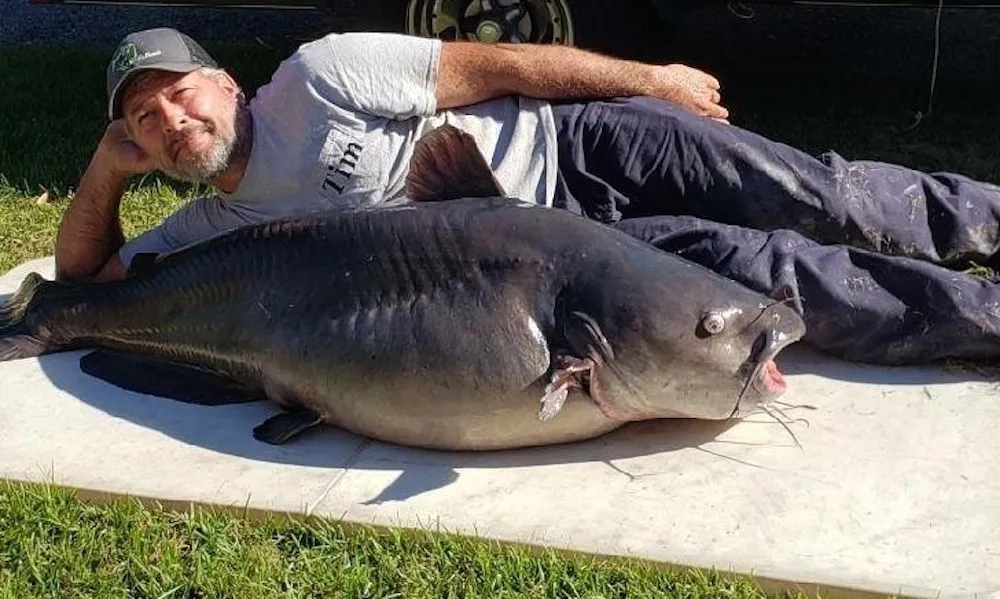🎣🐟 Hey there, aquatic adventurers! 🐟🎣
Ever wondered what titans lurk beneath the serene waters of Georgia? From shimmering lakes to meandering rivers, Georgia’s waters are brimming with tales of legendary catches and fishy giants.
Grab your fishing gear (or maybe just a comfy chair) and dive in with us as we reel in the stories of the ten most colossal fish that call Georgia home!
10. Bass, Smallmouth
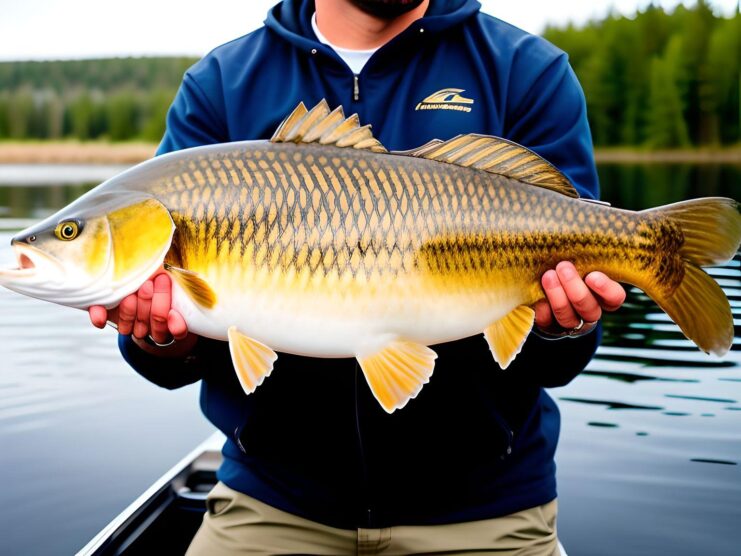
- Weight: 7 lb. 2 oz.
- Angler: Jack Hall
- Location: Lake Chatuge
- Date: March 1973
The Smallmouth Bass, a popular catch among freshwater anglers, is easily recognizable by its unique hue, earning it the nickname “bronzebacks.” This name is derived from its distinctive bronze or brownish coloration, which is especially prominent along its back and sides.
But it’s not just their appearance that sets them apart. When it comes to their temperament, especially when they feel the tug of a fishing line, these fish are nothing short of warriors.
Their fierce fighting spirit is legendary among fishing communities. Once hooked, they often display acrobatic leaps and powerful runs, challenging even the most experienced anglers.
This combination of beauty and brawn has made the Smallmouth Bass a sought-after prize in freshwater fishing, with many enthusiasts sharing tales of epic battles and memorable catches.
9. Bass, Spotted
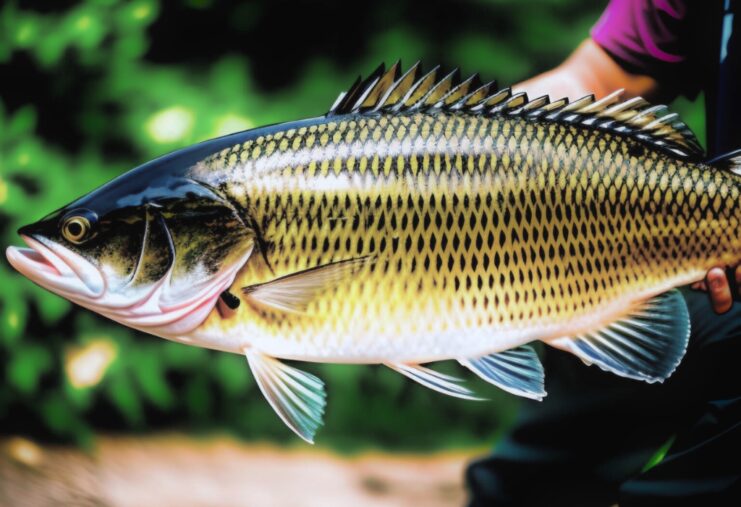
- Weight: 8 lb. 2 oz.
- Angler: Wayne Holland
- Location: Lake Burton
- Date: February 2005
The Spotted Bass, colloquially known as the “Kentucky bass,” stands out in the piscatorial world due to its remarkable adaptability. While many fish species have a preferred habitat or specific water conditions they thrive, the Spotted Bass is a testament to nature’s versatility.
Originating from the Mississippi River Basin and primarily identified by the distinctive dark spots below its lateral line, this fish has carved out a niche for itself in a variety of water bodies. In the vast expanses of reservoirs, the Spotted Bass finds ample space to hunt, using submerged structures like rocks and fallen trees as ambush points for prey. Their robust and streamlined bodies are well-suited for navigating these deeper waters, making them efficient predators.
This dual adaptability has earned the Spotted Bass respect among anglers. Whether they’re casting their lines in the tranquil waters of a reservoir or the bubbling currents of a mountain stream, they know that the Spotted Bass, with its keen instincts and survival skills, is a worthy adversary. The fish’s ability to flourish in such diverse habitats is a testament to its evolutionary prowess and a reminder of nature’s incredible capacity for adaptation.
8. Bass, Shoal
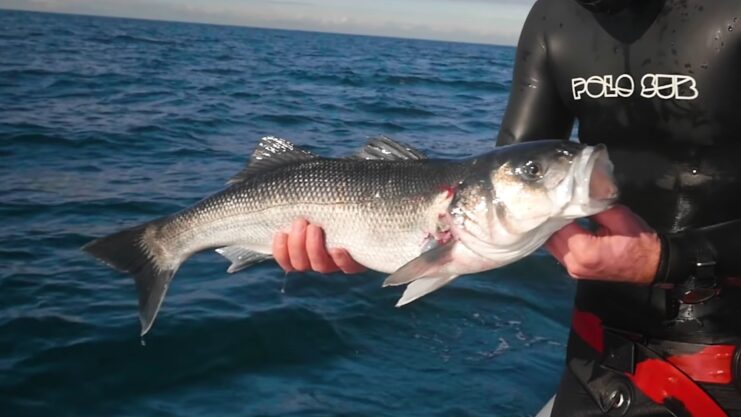
- Weight: 8 lb. 5 oz.
- Angler: Joseph McWhorter
- Location: Chattahoochee River
- Date: December 2021
The shoal Bass, a unique and lesser-known member of the black bass family, calls the Chattahoochee River system its home. This river, with its rich history and ecological significance, provides the perfect backdrop for the life of the Shoal Bass. Unlike some of its bass relatives that might prefer calmer waters, the Shoal Bass has a penchant for the wilder side of aquatic life.
Characterized by its olive-green hue with dark vertical markings, the Shoal Bass is specially adapted to thrive in the turbulent waters of the Chattahoochee. The river’s rocky terrains, interspersed with boulders and gravel beds, create fast-flowing rapids and swirling eddies. It’s within these challenging environments that the Shoal Bass truly shines. Its streamlined body, strong tail, and muscular build allow it to navigate these rapid waters with agility and precision, darting between rocks and using the currents to its advantage.
For anglers, the Shoal Bass presents a unique challenge. Fishing in the fast-flowing sections of the Chattahoochee requires skill, patience, and a bit of adventure. The reward, however, is the chance to catch one of the river’s native gems, a fish that embodies the wild spirit of the Chattahoochee’s rapids. The Shoal Bass’s presence in these waters serves as a testament to the river’s ecological richness and the intricate balance of life within its currents.
7. Gar, Longnose
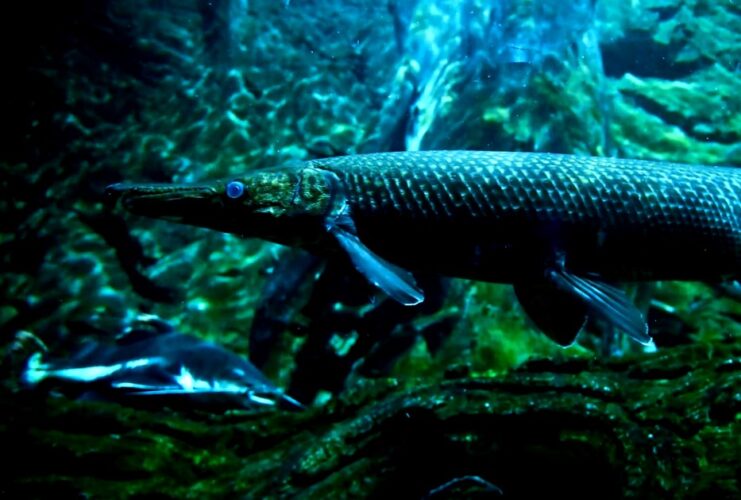
- Weight: 31 lb. 2 oz.
- Angler: Rachel Harrison
- Location: Coosa River
- Date: March 2022
The Longnose Gar, a true relic of the past, stands as a living testament to the ancient and diverse lineage of fish that once dominated our planet’s waters. With its unmistakable elongated snout, bristling with rows of needle-sharp teeth, this fish seems as if it has been plucked straight out of a prehistoric era—and in many ways, it has.
This remarkable species boasts a lineage that stretches back to a time when dinosaurs roamed the earth. Fossils of the Longnose Gar, remarkably similar to the living specimens we see today, have been discovered in layers of sediment over 100 million years old. This means that while colossal reptiles like the Tyrannosaurus and Velociraptor were asserting their dominance on land, the Longnose Gar was already a seasoned inhabitant of ancient waterways.
But what’s even more fascinating is the Longnose Gar’s resilience and adaptability. Over the eons, while countless species have emerged and vanished in the ever-changing dance of evolution, the Longnose Gar has remained relatively unchanged. Its sleek, armored body, designed for swift and agile movement, and its voracious hunting instincts have ensured its survival through myriad ecological changes.
6. Carp, Common
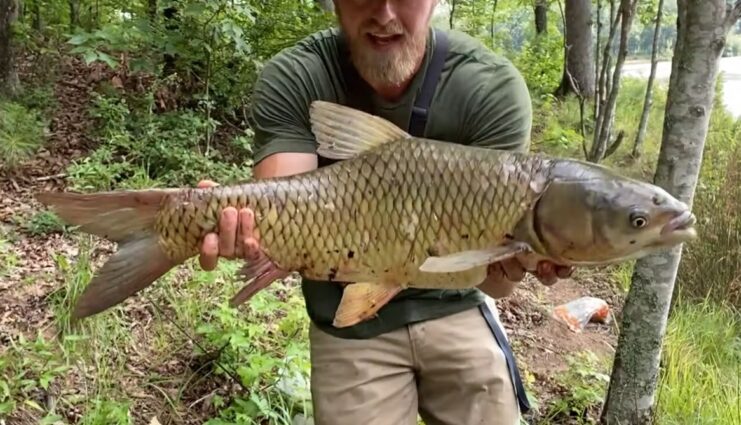
- Weight: 35 lb. 12 oz.
- Angler: Rev. Donald Clark
- Location: Lake Jackson
- Date: 1972
The Common Carp, with its shimmering scales and robust physique, traces its origins to the vast and varied waters of Asia. In its native habitat, spanning from the temperate regions of Central Asia to the waterways of China, the carp has been both a source of food and a symbol of perseverance and abundance for thousands of years. Ancient Chinese paintings and poetry often celebrated the carp’s graceful movements and resilience, and it was revered for its ability to swim upstream, even against powerful currents.
However, the story of the Common Carp took a dramatic turn in the 1800s. As global exploration and trade flourished, there was a keen interest in introducing various species to new environments, either for aesthetic purposes or potential economic benefits. The Common Carp, with its adaptability and hardiness, was seen as an ideal candidate for this. By the mid-19th century, it was purposefully introduced into North American waters.
Initially, the introduction was met with enthusiasm. The carp was seen as a solution to declining native fish stocks in some overfished waters, and its rapid proliferation was initially celebrated. However, as the carp began to spread, its impact on local ecosystems became more evident. The carp’s feeding habits, which involve rooting around the lakebed, can lead to increased water turbidity and disruption of native plant life. This, in turn, can affect native fish species and the overall health of freshwater ecosystems.
5. Muskellunge
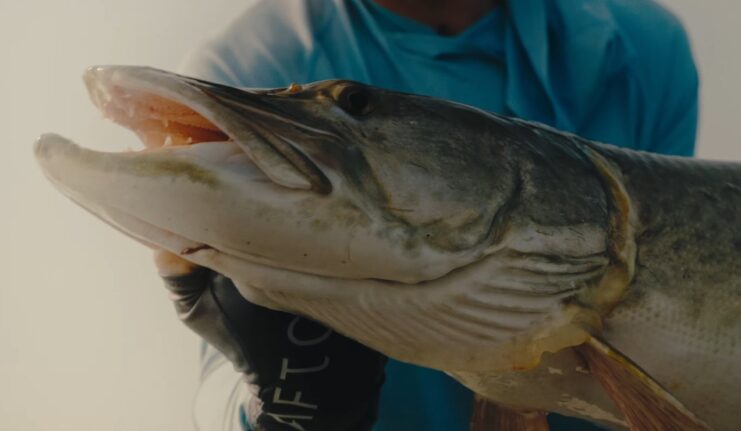
- Weight: 38 lb.
- Angler: Rube Golden
- Location: Blue Ridge Lake
- Date: June 1957
The Muskellunge, or “muskie” as it’s affectionately known among fishing enthusiasts, is a creature of legends in the angling world. With its sleek, torpedo-shaped body, sharp teeth, and predatory instincts, it’s no wonder that this fish has earned a reputation that’s almost mythical in stature. The moniker “fish of ten thousand casts” isn’t just a catchy phrase; it encapsulates the challenge and allure that the muskie presents to those who seek it.
Originating from the freshwater lakes and rivers of North America, the muskellunge is the largest member of the pike family. Its size, which can exceed 50 inches in length and weigh over 30 pounds, is impressive, but it’s the muskie’s elusive nature that truly sets it apart. Unlike other fish that might bite at bait more readily, the muskellunge is known for its discerning palate and wariness. It’s not easily fooled, and its habits of following bait without striking or simply ignoring lures altogether have led many anglers on long, often fruitless pursuits.
But why do anglers keep coming back, cast after cast, in search of this elusive giant? The answer lies in the thrill of the chase. The muskellunge’s reputation as a challenging catch only adds to its allure. Every cast into muskie territory is filled with anticipation. The water’s surface becomes a stage, and at any moment, a muskie might explode from the depths, providing a heart-stopping show of acrobatics and power. For those fortunate enough to hook one, the ensuing battle is a test of skill, strength, and patience.
4. Bass, Largemouth
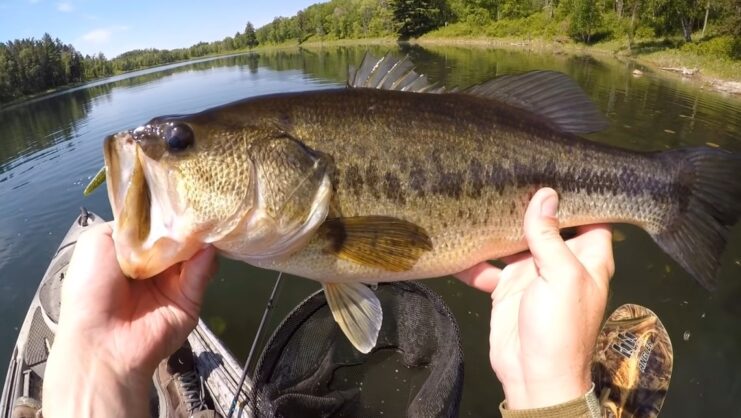
- Weight: 22 lb. 4 oz.
- Angler: George Perry
- Location: Montgomery Lake
- Date: June 1932
The Largemouth Bass, an iconic figure in the world of freshwater angling, holds a special place in the heart of Georgia. As the state’s official fish, it symbolizes not only Georgia’s rich aquatic heritage but also the passion and enthusiasm of its fishing community. With its wide, gaping mouth and striking greenish hue, the Largemouth Bass is instantly recognizable and has become a symbol of fishing excellence in the region.
But what truly sets the Largemouth Bass apart from other freshwater species is its spirited demeanor, especially when it feels the tug of an angler’s line. Unlike some fish that might surrender easily once hooked, the Largemouth Bass is known for putting up a formidable fight. Its aggressive behavior is legendary. Anglers often speak of the sudden, forceful strikes, where the bass ambushes the bait with a speed and ferocity that can catch even seasoned fishermen off guard.
Yet, the drama doesn’t end there. Once hooked, the Largemouth Bass is renowned for its acrobatic displays. It’s not uncommon to see this fish leap dramatically out of the water, performing aerial twists and turns in a bid to free itself. These jumps, often referred to as “tail dances,” are a sight to behold and are one of the reasons why bass fishing is considered such a thrilling sport. Each leap, each splash, adds to the adrenaline-filled experience, making the eventual catch, if successful, all the more rewarding.
3. Catfish, Flathead
- Weight: 83 lb.
- Angler: Carl Sawyer
- Location: Altamaha River
- Date: June 2006
The Flathead Catfish, with its broad, flattened head and mottled, olive-brown skin, is a formidable presence in freshwater habitats. As night falls and other aquatic creatures settle into a period of rest, the Flathead Catfish comes alive, embarking on its nightly hunt. This nocturnal behavior is a defining characteristic of the species and plays a crucial role in its predatory success.
The cover of darkness offers the Flathead Catfish several advantages. For one, its subdued coloration blends seamlessly with the murky riverbeds and lake bottoms, making it nearly invisible to potential prey. This natural camouflage, combined with its patient and stealthy approach, allows the catfish to ambush its prey with surprising speed and precision.
The diet of the Flathead Catfish is as diverse as the waters it inhabits. While fish, especially sunfish, shad, and smaller catfish, form a significant portion of its diet, the Flathead is not a picky eater. Its powerful jaws and sharp, conical teeth enable it to tackle a variety of prey. Crustaceans, such as crayfish, are often on the menu, their hard exoskeletons no match for the catfish’s crushing bite. Remarkably, the Flathead’s predatory prowess doesn’t stop at aquatic life. On occasions, small mammals venturing too close to the water’s edge, like rodents, can also fall victim to these opportunistic hunters.
2. Bass, Striped
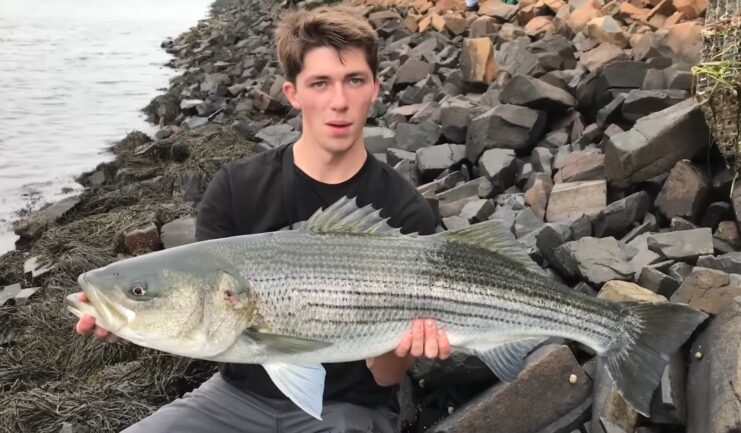
- Weight: 63 lb.
- Angler: Kelly Ward
- Location: Oconee River
- Date: May 1967
The Striped Bass, affectionately dubbed “stripers” by anglers and enthusiasts alike, boasts a fascinating life cycle that sets it apart from many other fish species. With its sleek silver body adorned with dark, horizontal stripes, the Striped Bass is not only a visual marvel but also an ecological wonder, primarily due to its anadromous nature.
The term “anadromous” paints a picture of a remarkable migratory journey. Fish that are anadromous are born in freshwater, migrate to the saltwater oceans to mature, and then make the arduous journey back to freshwater rivers and streams to reproduce. This cyclical migration is a testament to the Striped Bass’s adaptability and resilience.
When spring arrives, driven by an innate biological urge, mature stripers embark on their journey from the salty depths of the ocean to the freshwater spawning grounds of their birth. This migration is no small feat. The fish must navigate changing salinities, dodge predators, and overcome physical barriers like dams or waterfalls. The goal? To find the perfect spot in freshwater tributaries where they can lay their eggs, ensuring the next generation of Striped Bass.
1. Catfish, Blue
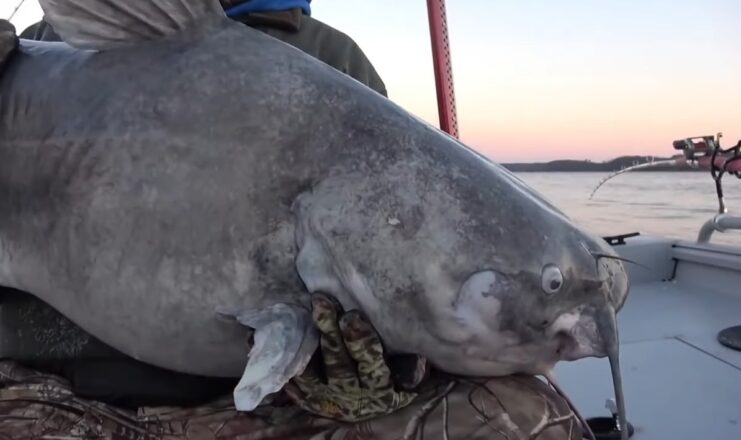
- Weight: 110 lb. 6 oz.
- Angler: Tim Trone
- Location: Chattahoochee River
- Date: October 2020
The Blue Catfish, a behemoth of Georgia’s freshwater realms, stands as a testament to the wonders that lie beneath the water’s surface. Holding the distinguished title for the heaviest fish ever caught in the state’s freshwater bodies, this species has become a stuff of legends among the angling community and aquatic enthusiasts alike.
With its smooth, slate-blue skin, whisker-like barbels, and a body that can grow to impressive lengths, the Blue Catfish is an awe-inspiring sight. But it’s not just its size that commands respect; it’s the fish’s longevity and role in the aquatic food chain that truly sets it apart. With a lifespan that often exceeds two decades, the Blue Catfish has ample time to grow to its record-breaking sizes, with some individuals weighing in at well over 100 pounds.
This extended lifespan allows the Blue Catfish to dominate its habitat. As apex predators, they sit at the very top of the food web. Their diet is vast and varied, encompassing a range of prey from smaller fish, including other catfish species, to crustaceans and even aquatic birds on occasion. Their voracious appetite and opportunistic feeding habits mean that they play a crucial role in regulating populations of other aquatic species, ensuring a balance in the ecosystem.
FAQs
Are all these fish native to Georgia?
While many of the fish listed are native to Georgia, some, like the common carp, were introduced from other regions. However, they’ve since established themselves and are now an integral part of Georgia’s aquatic ecosystems.
Can I fish for all these species in Georgia’s waters?
Yes, you can fish for these species in Georgia, but it’s essential to be aware of the state’s fishing regulations, seasons, and any catch-and-release guidelines to ensure sustainable fishing practices.
Is the Largemouth Bass really the state fish?
Absolutely! The Largemouth Bass is not only a favorite among anglers but also holds the honor of being Georgia’s official state fish.
How do these fish sizes compare to their average sizes?
The fish listed here represent some of the largest specimens caught in Georgia’s waters. In general, they are much larger than the average size you might encounter when fishing.
Are there any fishing tournaments – where I can try my luck at catching one of these giants?
Yes, Georgia hosts several fishing tournaments throughout the year, especially for species like the Largemouth Bass. It’s a great opportunity for anglers to showcase their skills and maybe even land a record-breaking catch!
I’m new to fishing. Any tips on where to start if I want to catch one of these big fish?
Welcome to the world of fishing! Georgia has numerous fishing spots, from lakes to rivers. For beginners, joining a local fishing club or hiring a guide can be beneficial. They can provide insights on the best spots, techniques, and times to fish. Remember, patience is key, and every fishing trip is an opportunity to learn and enjoy the great outdoors.
Conclusion
🌊🎉 And there you have it, fellow fish enthusiasts! 🎉🌊
From the stealthy catfish to the acrobatic bass, Georgia’s waters are a treasure trove of aquatic marvels. So, the next time you’re by a Georgian waterbody, give a nod to the underwater behemoths that might be swimming below. And who knows?
Maybe you’ll be inspired to embark on your own fishing adventure to meet these finned legends up close! Until then, keep those fishy tales coming and tight lines to all! 🐠🎣🌟
Related Posts:
- Top 8 Best Campgrounds in Iowa: Explore the Great…
- 8 Great Places To Go Glamping In Norway 2024 -…
- Biggest Fish in Arizona: Top 10 Largest Fish Species…
- Unveiling Venomous Snakes in Georgia: An Exciting…
- Discover 7 Best Camping Hotspots in Georgia! Embrace…
- Biggest Fish in Arkansas: In Search of the Titans

